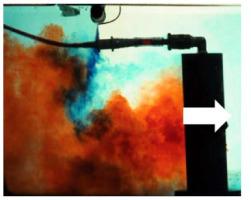Energy and Buildings ( IF 6.6 ) Pub Date : 2021-02-16 , DOI: 10.1016/j.enbuild.2021.110818 Narsing K. Jha , D. Frank , P.F. Linden

|
Air curtains are commonly used as separation barriers to reduce exchange flows through an open-door of a building. Here, we investigated the effectiveness of an air curtain to prevent the transport of contaminants by a person walking along a corridor from a dirty zone into a clean zone. We conducted small-scale waterbath experiments with fresh water, brine and sugar solutions, with the brine as a passive tracer for the contaminant in the wake of a person. A cylinder representing a moving person was pulled between two fixed points in the channel across the air curtain. We observed that the air curtain can prevent up to 40% of the contaminant transport due to the wake of a moving person. We proposed a new way to evaluate the performance of an air curtain in terms of the deflection modulus and the effectiveness defined for this iso-density situation, similar to quantities typically used for the case where the fluid densities in the two zones are different. We observed that the air curtain has an optimal operating condition to achieve a maximum effectiveness. Dye visualisations and time-resolved particle image velocimetry of the air curtain and the cylinder wake were used to examine the re-establishment process of the planar jet after its disruption by the cylinder and we observed that some part of the wake is separated by the re-establishing curtain. We observed that the exchange flux peaks after the cylinder passes the air curtain and reduces to a typical value after the re-establishment of the curtain.
中文翻译:

人体通过隔离走廊两部分的气幕的污染物运输:第一部分-均匀的环境温度
气幕通常用作分隔屏障,以减少通过建筑物敞开门的交换流量。在这里,我们研究了气幕防止污染物沿走廊从肮脏区域进入清洁区域的传输的有效性。我们使用淡水,盐水和糖溶液进行了小规模的水浴实验,盐水作为被动示踪剂追踪人身后的污染物。在横过气幕的通道中的两个固定点之间,拉出了一个代表正在移动的人的圆柱体。我们观察到,由于移动的人的醒来,气幕可以阻止多达40%的污染物迁移。我们提出了一种新的方式来评估空气幕的性能,该方式取决于挠度模量和为此等密度情况定义的有效性,类似于两个区域中流体密度不同的情况下通常使用的数量。我们观察到,气幕具有最佳的工作条件,可实现最大的效率。染料的可视化和气幕和气缸尾流的时间分辨粒子图像测速技术用于检查平面射流被气缸破坏后的重建过程,我们观察到尾流的某些部分被重心分离-建立帷幕。我们观察到交换通量在气缸通过气帘后达到峰值,并在气帘重新建立后降低到典型值。我们观察到,气幕具有最佳的工作条件,可实现最大的效率。染料的可视化和气幕和气缸尾流的时间分辨粒子图像测速技术用于检查平面射流被气缸破坏后的重建过程,我们观察到尾流的某些部分被重心分离-建立帷幕。我们观察到交换通量在气缸通过气帘后达到峰值,并在气帘重新建立后降低到典型值。我们观察到,气幕具有最佳的工作条件,可实现最大的效率。染料的可视化和气幕和气缸尾流的时间分辨粒子图像测速技术用于检查平面射流被气缸破坏后的重建过程,我们观察到尾流的某些部分被重心分离-建立帷幕。我们观察到,在圆柱体通过气帘之后,交换通量达到峰值,并在气帘重新建立后降低到典型值。染料的可视化和气幕和气缸尾流的时间分辨粒子图像测速技术用于检查平面射流被气缸破坏后的重建过程,我们观察到尾流的某些部分被重心分离-建立帷幕。我们观察到,在圆柱体通过气帘之后,交换通量达到峰值,并在气帘重新建立后降低到典型值。空气幕和圆柱状尾流的染料可视化和时间分辨粒子图像测速技术用于检查平面射流被圆柱状破碎后的重建过程,我们观察到尾流的某些部分被重心分离-建立帷幕。我们观察到交换通量在气缸通过气帘后达到峰值,并在气帘重新建立后降低到典型值。











































 京公网安备 11010802027423号
京公网安备 11010802027423号